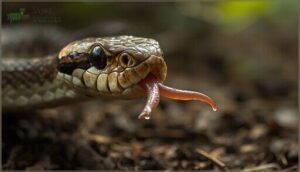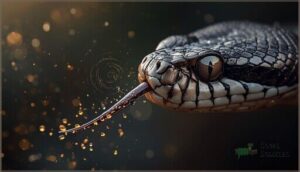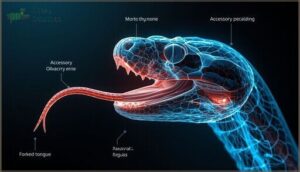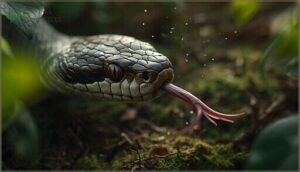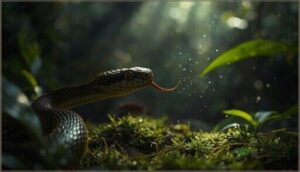This site is supported by our readers. We may earn a commission, at no cost to you, if you purchase through links.
A snake’s tongue can elongate up to 130% of its resting length, darting out dozens of times per minute to sample the invisible chemical landscape surrounding its body. This isn’t a nervous tic or intimidation display—it’s a complex chemosensory mechanism that transforms volatile airborne molecules into survival-critical information.
When snakes flick their tongues, they’re fundamentally “tasting” the air, but the process is far more complex than simple chemical detection. The forked tips collect particles from different spatial locations, delivering them to paired openings in the roof of the mouth where the vomeronasal organ decodes directional cues with stereo precision.
This auxiliary olfactory system doesn’t just detect prey, mates, or threats—it constructs a three-dimensional chemical map that guides every decision a snake makes, from tracking wounded prey across varied terrain to avoiding predators lurking beyond visual range.
Table Of Contents
- Key Takeaways
- Why Do Snakes Flick Their Tongues?
- Anatomy and Mechanism of Snake Tongue Flicking
- Key Functions of Tongue Flicking in Snakes
- Biomechanics and Variation in Tongue Flicking
- Evolutionary Significance and Survival Implications
- Frequently Asked Questions (FAQs)
- Do snakes do tongue flicks?
- Why do snakes stick their tongues out?
- Why is a snake’s tongue forked?
- Do snakes flick their tongues when sleeping?
- How often do snakes flick their tongues daily?
- Can snakes smell without flicking their tongues?
- Do baby snakes flick tongues differently than adults?
- Why do some snakes flick faster than others?
- Conclusion
Key Takeaways
- Snakes flick their forked tongues to sample chemical particles from the air and surfaces, building a three-dimensional map of their environment for survival.
- Each tongue flick delivers scent molecules to the vomeronasal organ, allowing snakes to pinpoint prey, mates, and threats with stereo precision.
- Tongue flicking is a specialized, evolved behavior—not a sign of aggression or taste testing—that enables rapid, directional chemical detection far beyond what nostrils alone can achieve.
- Losing tongue function severely impairs a snake’s ability to hunt, find mates, and avoid predators, highlighting its critical role in their daily lives.
Why Do Snakes Flick Their Tongues?
If you’ve ever watched a snake and wondered why it constantly flicks that slender, forked tongue in and out, you’re not alone—people have been puzzling over this behavior since Aristotle’s time.
The answer isn’t what early naturalists guessed, and it’s far more intricate than a simple taste test.
Let’s break down the real science behind this iconic reptilian behavior and clear up some persistent misconceptions along the way.
Gathering Chemical Information From The Environment
Chemical sampling drives every tongue flick you observe in a snake. When that forked tongue darts out, it’s capturing environmental cues—both volatile airborne particles and nonvolatile chemical stimuli from surfaces. This sensory adaptation facilitates:
- Odor detection through specialized vomeronasal function
- Prey tracking via scent trail analysis
- Threat assessment through chemosensation
Your snake isn’t tasting—it’s reading its world molecularly. The process involves complex chemical gradient analysis to understand its surroundings.
Role of The Vomeronasal (Jacobson’s) Organ
Once your snake retracts its tongue, those captured chemical stimuli hit the vomeronasal organ—Jacobson’s organ—located on the mouth’s roof. Each fork tip delivers signals separately to paired openings, creating “stereo smell” that pinpoints odor direction.
This auxiliary olfactory system processes vomodors through specialized neural pathways, triggering immediate behavioral responses. It’s how snakes detect prey calcium-binding proteins, pheromones, and threats with striking precision.
The unique ability of snakes to smell in stereo smell mode allows them to navigate their environment with great accuracy.
Debunking Common Myths About Snake Tongue Flicking
Despite this intricate sensory apparatus, you’ll encounter persistent Tongue Flick Myths. Many believe snake tongue flicking signals aggression or venom delivery—pure Reptile Folklore.
Studies show 62% wrongly think rapid Flicking Behavior precedes attack, yet only 11% of bites follow tongue flicking. The tongue carries no venom; fangs alone deliver it.
This Snake Sensory tool functions for chemoreception through Jacobson’s organ, not intimidation or taste, debunking widespread Venom Misconceptions about chemical stimuli detection.
Anatomy and Mechanism of Snake Tongue Flicking
You can’t fully appreciate tongue-flicking without understanding what’s actually happening beneath the surface. A snake’s tongue isn’t just a simple muscle—it’s a specialized tool with unique structural adaptations that make chemical sampling possible.
Let’s break down the anatomy, collection mechanism, and neural pathway that turn a flickering tongue into a complex sensory system.
Structure and Mobility of The Forked Tongue
Unlike most organs you’re familiar with, the snake’s forked tongue relies on pure muscle—no bone, no rigid scaffold. This hydrostatic structure elongates up to 130% in its posterior half, shooting forward at velocities exceeding 4 meters per second.
Each bifurcated tine maneuvers independently, sweeping wider spatial areas than any single-tipped tongue could manage, maximizing your understanding of chemosensory precision.
How The Tongue Collects Chemical Particles
When you watch the tongue flicking, airflow patterns form dual vortices that pull odor molecules directly onto each fork. Tongue morphology—those split tines—captures bilateral samples simultaneously, feeding vomerolfaction through Jacobson’s organ.
Particle adhesion relies on moisture coating the epithelium, trapping chemicals for chemosensation. Tongue movements create concentrated chemical binding zones, transforming sparse airborne cues into sensory data your snake’s brain decodes instantly.
Pathway From Tongue to Vomeronasal Organ
Once the tongue retracts, chemical particles transfer into Jacobson’s organ through paired openings in the mouth roof. Neural signal transmission begins immediately—cranial nerve zero fires signals to the accessory olfactory bulb, then routes through the amygdala.
This olfactory system integration converts tongue movements into rapid chemosensation, enabling precise vomerolfaction that drives your snake’s behavioral responses to prey, mates, and threats.
Key Functions of Tongue Flicking in Snakes
Now that you understand how a snake’s forked tongue collects chemical particles and delivers them to the vomeronasal organ, you’re ready to see this sensory system in action.
Tongue flicking isn’t just anatomical curiosity—it’s survival machinery that shapes every aspect of a snake’s life. Let’s break down the three primary functions that make this behavior essential for moving through a world built on scent.
Locating Prey and Tracking Scent Trails
When you’re tracking prey in the wild, precision matters. Snakes use tongue flicking to follow scent trails with striking accuracy, flicking up to 22 times per second during active hunts.
Their forked tongues collect scent molecules from two points simultaneously, creating a “stereo smell” effect. Chemical cues funnel to the Jacobson’s organ, enabling snakes to pinpoint prey direction and recapture envenomated targets efficiently.
Detecting Mates and Pheromones
Finding a mate in the wild isn’t guesswork—it’s biochemistry in action. Male snakes rely on tongue flicking to detect female pheromones, sampling airborne chemical signals that reveal species identity and reproductive readiness.
Their forked tongues create “stereo smell,” allowing accurate pheromone trail following. The Jacobson’s organ converts these chemical signals into neural impulses, triggering courtship behaviors.
Oscillating tongue flicks can sample 100 times more pheromones than simple flicks, dramatically improving mate detection efficiency.
Sensing Predators and Environmental Changes
Predator Detection turns every tongue flick into a chemical surveillance system. Your snake’s forked tongue creates airflow vortices that trap predator odors, sampling up to 100 times faster than passive sniffing—critical for Threat Assessment when survival hangs in the balance.
- Environmental Monitoring: Tongue movements detect habitat changes like smoke or pollution, guiding evasion decisions
- Spatial tracking: The Jacobson’s organ processes scent from each fork independently, pinpointing predator direction
- Behavioral shifts: Flick rates double when Survival Strategies activate against nearby threats
Biomechanics and Variation in Tongue Flicking
You’ve seen the tongue flash in and out, but the physics behind that movement reveal something extraordinary about how snakes engineer their sensory world.
The mechanics aren’t uniform—different flicking patterns and species-specific variations show how evolution fine-tuned this behavior for diverse ecological challenges.
Let’s break down how airflow dynamics, flicking styles, and anatomical differences shape the way snakes sample their environment.
Airflow Dynamics and Odor Collection
When your snake’s tongue darts through the air, it’s choreographing invisible vortices—nature’s own chemical net. These counter-rotating airflow patterns funnel odor molecules directly onto the forked tips, where mucus traps scent molecules for delivery to Jacobson’s organ. Tongue kinematics create boundary layer thinning that accelerates diffusion, transforming simple tongue movements into precision chemical sampling instruments that let snakes smell environments in three-dimensional space.
A snake’s tongue creates spinning vortices that funnel scent molecules into mucus traps, turning air into readable chemical maps
| Airflow Feature | Function in Chemical Sampling |
|---|---|
| Counter-rotating vortices | Draw fresh odor molecules toward tongue tips |
| Spatial airflow separation | Enable directional “stereo” smelling |
| Boundary layer thinning | Accelerate odorant diffusion onto tongue surface |
| Vortex formation dynamics | Enhance encounter rates across species sizes |
Types of Tongue Flicks (Oscillatory Vs. Simple)
Your snake doesn’t just flick its tongue one way—it chooses between two distinct techniques depending on what it’s trying to smell. Oscillatory flicks involve rapid semicircular sweeps that generate standing vortices, sampling airborne chemicals through complex tongue movements. Simple flicks extend straight down to taste surfaces directly, capturing nonvolatile compounds through quick contact.
How these flicking frequencies differ:
- Oscillatory patterns create counter-rotating airflow that pulls volatile odorants toward the forked tips, with smaller snakes executing 9-11 rapid oscillations at tongue tip velocities reaching 3 m/s
- Simple extensions provide immediate chemical information from substrates through brief, straight downward movements without oscillatory complexity
- Duration variance means oscillatory flicks last 2-3 times longer than simple ones, sampling up to 100 times more air volume for enhanced vomeronasal organ processing
- Behavioral switching allows snakes to shift from exploratory oscillatory sampling to confirmatory simple flicks when external stimuli—like tactile input—trigger mode changes in their reptile sensory systems
Species Differences and Ecological Adaptations
Beyond behavioral switching, tongue flick variations reflect each species’ ecological niche. Larger snakes like Coluber constrictor flick slower with fewer oscillations (3-4), while smaller Storeria dekayi execute rapid 9-11 oscillation bursts. Aquatic species face sensory tradeoffs—fewer olfactory genes compensate for water’s slow chemical diffusion, shifting reliance from tongue flicking to mechanoreception.
Habitat influences everything: arboreal, terrestrial, or aquatic environments shape how a snake’s Jacobson’s organ processes ecological adaptation through specialized sensory perception and behavior patterns.
| Snake Type | Tongue Flicking Adaptation |
|---|---|
| Large terrestrial | Slower flicks, fewer oscillations (3-4) |
| Small terrestrial | Rapid flicks, many oscillations (9-11) |
| Aquatic species | Reduced olfactory genes, enhanced touch |
| Arboreal species | Context-specific sensory balancing |
Evolutionary Significance and Survival Implications
The forked tongue didn’t just happen by accident—it’s the result of millions of years of evolutionary refinement that transformed snakes into some of nature’s most efficient chemical detectors. This specialized adaptation has become so integral to snake survival that losing it would fundamentally compromise their ability to hunt, reproduce, and avoid danger.
Let’s explore how this extraordinary organ evolved and why it remains absolutely critical to every aspect of a snake’s life.
Evolution of The Forked Tongue in Snakes
Adaptation shaped snake tongues into chemical detection marvels. The forked tongue has evolved independently multiple times among squamate reptiles, demonstrating convergent evolution tied to ecological demands.
This bifurcated tongue morphology optimizes odor molecule collection through:
- Stereo olfaction – simultaneous chemical gradient sampling from both sides
- Enhanced vomeronasal input – dual pathways feeding paired Jacobson’s organs
- Adaptive radiation – morphological variations matching specific habitat niches
Tongue flicking represents evolutionary innovation refined across millennia.
Impact on Hunting, Mating, and Predator Avoidance
Tongue flick rates shift dramatically depending on whether you’re watching a snake hunt, court, or flee. During active hunting, your snake performs six to seven rapid flicks in a third of a second—chemical signaling at peak intensity. Males tracking mating cues spend more time investigating female pheromone trails, while gravid females heighten predator detection sensitivity through increased tongue flicking when threatened.
| Survival Function | Tongue Flicking Behavior | Evolutionary Advantage |
|---|---|---|
| Hunting Strategies | Rapid successive flicks gather prey chemical signatures | 100× faster odor collection than ground contact |
| Mating Cues | Prolonged investigatory flicks near conspecific pheromones | Species-specific mate recognition prevents wasted courtship |
| Predator Avoidance | Elevated flick sequences during threat encounters | Spatial scent discrimination facilitates precise threat localization |
| Prey Detection | Slow controlled flicks track odor trails | Enhanced localization through Jacobson’s organ processing |
This multifunctional chemosensory system transforms snake behavior into a finely-tuned survival instrument.
Consequences of Tongue Loss on Snake Survival
Losing chemosensory function creates cascading survival challenges you’ll rarely witness in nature. While tongue regeneration occurs over 8–14 months in some species, most snakes face immediate deficits:
- Prey detection accuracy drops without bilateral chemical sampling
- Mate location fails as pheromone tracking diminishes
- Predator avoidance weakens through reduced environmental scanning
- Survival rates plummet in wild populations
- Chemosensory decline persists until full tongue regeneration completes
Adaptive strategies remain limited—your snake’s Jacobson’s organ depends entirely on tongue flicking for functional sensory input.
Frequently Asked Questions (FAQs)
Do snakes do tongue flicks?
Yes, snakes flick their tongues constantly—sometimes sampling up to 100 times more air with oscillatory flicks than simple downward ones, maximizing chemical sampling efficiency for hunting, navigation, and survival.
Why do snakes stick their tongues out?
When you see a snake extending its forked tongue, it’s actively sampling chemical particles from the air and surfaces—a complex chemosensory behavior central to survival, navigation, and communication within reptile sensory systems.
Why is a snake’s tongue forked?
A snake’s forked tongue functions as stereo chemical detection, sampling scent molecules simultaneously from two spatial points.
This bifurcated morphology provides directional tracking precision—an adaptive advantage enabling prey location, mate detection, and predator avoidance through enhanced vomeronasal processing.
Do snakes flick their tongues when sleeping?
No, snakes don’t flick their tongues during sleep. Tongue flicking requires alertness—it’s an active sensing behavior.
During rest, their metabolism drops, muscles relax, and sensory sampling through the vomeronasal organ ceases completely.
How often do snakes flick their tongues daily?
Depending on their level of alertness, your snake’s tongue flick rates can range dramatically—from under one flick per minute during rest to over fifteen when actively investigating prey scent trails or environmental cues.
Can snakes smell without flicking their tongues?
Yes, you’ll find snakes can detect odors through their nostrils and olfactory systems. However, this smell perception is far less efficient than tongue flicking, which delivers scent molecules directly to Jacobson’s organ for enhanced chemical detection.
Do baby snakes flick tongues differently than adults?
Curiously, Tongue Flick Rates in neonates run higher—think rapid-fire sampling—while adults slow down, refining Flicking Patterns as their Jacobson’s organ matures.
This shift in Juvenile Behavior marks Growth Stages vital to snake biology and reptile behavior.
Why do some snakes flick faster than others?
Tongue Flick Rate varies with Snake Size Variance, environmental influences, and species adaptation.
Smaller snakes, for instance, flick rapidly due to higher metabolic rates and specialized flicking mechanics, optimizing Jacobsons organ function for efficient chemical detection in diverse reptile sensory systems.
Conclusion
Imagine a snake as a seasoned traveler traversing a dense, invisible forest—each flick of its tongue is a lantern casting light on hidden trails. This intricate dance answers the question of why snakes flick their tongues: it’s their way of reading the world’s secret script, decoding messages that eyes alone can’t see.
As you walk your own path, remember, sometimes the most critical signals are sensed, not seen—if only you’re bold enough to notice.
- http://chemse.oxfordjournals.org/content/37/9/883.long
- https://www.zmescience.com/science/why-snakes-flick-tongues-30052018/
- https://theconversation.com/explainer-why-do-snakes-flick-their-tongues-29935
- https://zooatlanta.org/the-fascinating-world-of-tongue-flicking/
- https://timesofindia.indiatimes.com/etimes/trending/how-sea-snakes-evolved-to-smell-underwater-insights-from-their-changing-olfactory-genes/articleshow/125173440.cms


